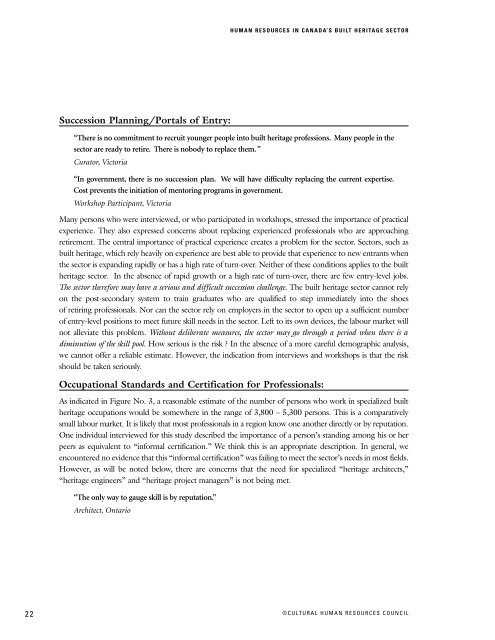Human Resources in Canada's Built Heritage Sector: Mapping the ...
Human Resources in Canada's Built Heritage Sector: Mapping the ...
Human Resources in Canada's Built Heritage Sector: Mapping the ...
- No tags were found...
Create successful ePaper yourself
Turn your PDF publications into a flip-book with our unique Google optimized e-Paper software.
HUMAN RESOURCES IN CANADA’S BUILT HERITAGE SECTORSuccession Plann<strong>in</strong>g/Portals of Entry:“There is no commitment to recruit younger people <strong>in</strong>to built heritage professions. Many people <strong>in</strong> <strong>the</strong>sector are ready to retire. There is nobody to replace <strong>the</strong>m. ”Curator, Victoria“In government, <strong>the</strong>re is no succession plan. We will have difficulty replac<strong>in</strong>g <strong>the</strong> current expertise.Cost prevents <strong>the</strong> <strong>in</strong>itiation of mentor<strong>in</strong>g programs <strong>in</strong> government.Workshop Participant, VictoriaMany persons who were <strong>in</strong>terviewed, or who participated <strong>in</strong> workshops, stressed <strong>the</strong> importance of practicalexperience. They also expressed concerns about replac<strong>in</strong>g experienced professionals who are approach<strong>in</strong>gretirement. The central importance of practical experience creates a problem for <strong>the</strong> sector. <strong>Sector</strong>s, such asbuilt heritage, which rely heavily on experience are best able to provide that experience to new entrants when<strong>the</strong> sector is expand<strong>in</strong>g rapidly or has a high rate of turn-over. Nei<strong>the</strong>r of <strong>the</strong>se conditions applies to <strong>the</strong> buil<strong>the</strong>ritage sector. In <strong>the</strong> absence of rapid growth or a high rate of turn-over, <strong>the</strong>re are few entry-level jobs.The sector <strong>the</strong>refore may have a serious and difficult succession challenge. The built heritage sector cannot relyon <strong>the</strong> post-secondary system to tra<strong>in</strong> graduates who are qualified to step immediately <strong>in</strong>to <strong>the</strong> shoesof retir<strong>in</strong>g professionals. Nor can <strong>the</strong> sector rely on employers <strong>in</strong> <strong>the</strong> sector to open up a sufficient numberof entry-level positions to meet future skill needs <strong>in</strong> <strong>the</strong> sector. Left to its own devices, <strong>the</strong> labour market willnot alleviate this problem. Without deliberate measures, <strong>the</strong> sector may go through a period when <strong>the</strong>re is adim<strong>in</strong>ution of <strong>the</strong> skill pool. How serious is <strong>the</strong> risk ? In <strong>the</strong> absence of a more careful demographic analysis,we cannot offer a reliable estimate. However, <strong>the</strong> <strong>in</strong>dication from <strong>in</strong>terviews and workshops is that <strong>the</strong> riskshould be taken seriously.Occupational Standards and Certification for Professionals:As <strong>in</strong>dicated <strong>in</strong> Figure No. 3, a reasonable estimate of <strong>the</strong> number of persons who work <strong>in</strong> specialized buil<strong>the</strong>ritage occupations would be somewhere <strong>in</strong> <strong>the</strong> range of 3,800 – 5,300 persons. This is a comparativelysmall labour market. It is likely that most professionals <strong>in</strong> a region know one ano<strong>the</strong>r directly or by reputation.One <strong>in</strong>dividual <strong>in</strong>terviewed for this study described <strong>the</strong> importance of a person’s stand<strong>in</strong>g among his or herpeers as equivalent to “<strong>in</strong>formal certification.” We th<strong>in</strong>k this is an appropriate description. In general, weencountered no evidence that this “<strong>in</strong>formal certification” was fail<strong>in</strong>g to meet <strong>the</strong> sector’s needs <strong>in</strong> most fields.However, as will be noted below, <strong>the</strong>re are concerns that <strong>the</strong> need for specialized “heritage architects,”“heritage eng<strong>in</strong>eers” and “heritage project managers” is not be<strong>in</strong>g met.“The only way to gauge skill is by reputation.”Architect, Ontario22©CULTURAL HUMAN RESOURCES COUNCIL










